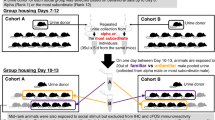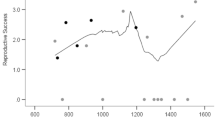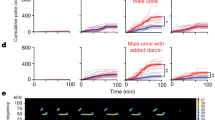Abstract
The ability to recognize individuals is essential to many aspects of social behaviour, such as the maintenance of stable social groups, parent–offspring or mate recognition, inbreeding avoidance and the modulation of competitive relationships. Odours are a primary mediator of individuality signals among many mammals1. One source of odour complexity in rodents, and possibly in humans, resides in the highly polymorphic major histocompatibility complex (MHC)2. The olfactory acuity of mice3 and rats4 allows them to distinguish between the urinary odours of congenic strains differing only in single genes within the MHC, although the chemical mediators or odorants are unknown. However, rodent urine also contains a class of proteins, termed major urinary proteins (MUPs)5, that bind and release small volatile pheromones6,7. We have shown that the combinatorial diversity of expression of MUPs among wild mice might be as great as for MHC, and at protein concentrations a million times higher8. Here we show in wild house mice (Mus domesticus) that urinary MUPs play an important role in the individual recognition mechanism.
This is a preview of subscription content, access via your institution
Access options
Subscribe to this journal
Receive 51 print issues and online access
$199.00 per year
only $3.90 per issue
Buy this article
- Purchase on Springer Link
- Instant access to full article PDF
Prices may be subject to local taxes which are calculated during checkout




Similar content being viewed by others
References
Brown, R. E. & McDonald, D. W. Social Odours in Mammals Vols 1 & 2 (Clarendon, Oxford, 1985).
Yamazaki, K., Singer, A. & Beauchamp, G. K. Origin, functions and chemistry of H-2 regulated odorants. Genetica 104, 235–240 (1999).
Yamazaki, K. et al. Sensory distinction between H-2b and H-2bm1 mutant mice. Proc. Natl Acad. Sci. USA 80, 5685–5688 (1983).
Singh, P. B., Brown, R. E. & Roser, B. MHC antigens in urine as olfactory recognition cues. Nature 327, 161–146 (1987).
Beynon, R. J., Robertson, D. H. L., Hubbard, S. J., Gaskell, S. J. & Hurst, J. L. in Advances in Chemical Communication in Vertebrates (eds Johnston, R. E., Muller-Schwarze, D. & Sorensen, P.) 137–147 (Plenum, New York, 1999).
Bacchini, A., Gaetani, E. & Cavaggioni, A. Pheromone binding proteins of the mouse, Mus musculus. Experientia 48, 419–421 (1992).
Robertson, D. H. L., Beynon, R. J. & Evershed, R. P. Extraction, characterization and binding analysis of two pheromonally active ligands associated with major urinary protein of house mouse (Mus musculus). J. Chem. Ecol. 19, 1405–1416 (1993).
Beynon, R. J. et al. in Chemical Signals in Vertebrates (eds Marchelewska-Koj, A., Muller-Schwarze, D. & Lepri, J.) 149–156 (Plenum, New York, 2001).
Hurst, J. L., Robertson, D. H. L., Tolladay, U. & Beynon, R. J. Proteins in urine scent marks of male house mice extend the longevity of olfactory signals. Anim. Behav. 55, 1289–1297 (1998).
Humphries, R. E., Robertson, D. H. L., Beynon, R. J. & Hurst, J. L. Unravelling the chemical basis of competitive scent marking in house mice. Anim. Behav. 58, 1177–1190 (1999).
Mucignat-Caretta, C. & Caretta, A. Urinary chemical cues affect light avoidance behaviour in male laboratory mice, Mus musculus. Anim. Behav. 57, 765–769 (1999).
Jemiolo, D., Alberts, J., Sochinski-Wiggins, S., Harvey, S. & Novotny, M. Behavioural and endocrine responses of female mice to synthetic analogs of volatile compounds in male urine. Anim. Behav. 33, 1114–1118 (1985).
Novotny, M. V., Ma, W., Wiesler, D. & Zidek, L. Positive identification of the puberty-accelerating pheromone of the house mouse: the volatile ligands associating with the major urinary protein. Proc. R. Soc. Lond. B 266, 2017–2022 (1999).
Jemiolo, B., Harvey, S. & Novotny, M. Promotion of the Whitten effect in female mice by synthetic analogs of male urinary constituents. Proc. Natl Acad. Sci. USA 83, 4576–4579 (1986).
Marchlewska-Koj, A., Cavaggioni, A., Mucignat-Caretta, C. & Olejniczak, P. Stimulation of estrus in female mice by male urinary proteins. J. Chem. Ecol. 26, 2355–2366 (2000).
Novotny, M., Harvey, S., Jemiolo, B. & Alberts, J. Synthetic pheromones that promote inter-male aggression in mice. Proc. Natl Acad. Sci. USA 82, 2059–2061 (1985).
Brennan, P. A., Schellinck, H. M. & Keverne, E. B. Patterns of expression of the immediate-early gene egr-1 in the accessory olfactory bulb of female mice exposed to pheromonal constituents of male urine. Neuroscience 90, 1463–1470 (1999).
Nevison, C. M., Barnard, C. J., Beynon, R. J. & Hurst, J. L. The consequences of inbreeding for recognising competitors. Proc. R. Soc. Lond. B 267, 687–694 (2000).
Hurst, J. L. et al. in Chemical Signals in Vertebrates (eds Marchelewska-Koj, A., Muller-Schwarze, D. & Lepri, J.) 43–50 (Plenum, New York, 2001).
Bishop, J. O., Clark, A. J., Clissold, P. M., Hainey, S. & Francke, U. Two main groups of mouse major urinary protein genes, both largely located on chromosome 4. EMBO J. 1, 615–620 (1982).
Robertson, D. H., Cox, K. A., Gaskell, S. J., Evershed, R. P. & Beynon, R. J. Molecular heterogeneity in the major urinary proteins of the house mouse Mus musculus. Biochem. J. 316, 265–672 (1996).
Payne, C. E. et al. in Chemical Signals in Vertebrates (eds Marchelewska-Koj, A., Muller-Schwarze, D. & Lepri, J.) 233–240 (Plenum, New York, 2001).
Hurst, J. L. Urine marking in populations of wild house mice Mus domesticus Rutty. 1. Communication between males. Anim. Behav. 40, 209–222 (1990).
Lücke, C. et al. Solution structure of a recombinant mouse major urinary protein. Eur. J. Biochem. 266, 1210–1218 (1999).
Novotny, M., Harvey, S. & Jemiolo, B. Chemistry of male dominance in the house mouse, Mus domesticus. Experientia 46, 109–113 (1990).
Krieger, J. et al. Selective activation of G protein subtypes in the vomeronasal organ upon stimulation with urine-derived compounds. J. Biol. Chem. 274, 4655–4662 (1999).
Marie, A. D. et al. Effect of polymorphisms on ligand binding by mouse major urinary proteins. Protein Sci. 10, 411–417 (2001).
Singer, A. G., Tsuchiya, H., Wellington, J. L., Beauchamp, G. K. & Yamazaki, K. Chemistry of odortypes in mice—fractionation and bioassay. J. Chem. Ecol. 19, 569–579 (1993).
Singer, A. G., Beauchamp, G. K. & Yamazaki, K. Volatile signals of the major histocompatibility complex in male mouse urine. Proc. Natl Acad. Sci. USA 94, 2210–2214 (1997).
Pearse-Pratt, R., Schellinck, H., Brown, R., Singh, P. B. & Roser, B. Soluble MHC antigens and olfactory recognition of genetic individuality: the mechanism. Genetica 104, 223–230 (1999).
Acknowledgements
This work was supported by Biotechnology and Biological Sciences Research Council (BBSRC) grants to J.L.H. and R.J.B., a BBSRC studentship to C.E.P. and an Egyptian government scholarship to A.D.M.
Author information
Authors and Affiliations
Corresponding author
Ethics declarations
Competing interests
The authors declare no competing financial interests.
Rights and permissions
About this article
Cite this article
Hurst, J., Payne, C., Nevison, C. et al. Individual recognition in mice mediated by major urinary proteins. Nature 414, 631–634 (2001). https://doi.org/10.1038/414631a
Received:
Accepted:
Issue Date:
DOI: https://doi.org/10.1038/414631a
This article is cited by
-
Dynamic changes to signal allocation rules in response to variable social environments in house mice
Communications Biology (2023)
-
Carbonic anhydrase IV in lizard chemical signals
Scientific Reports (2023)
-
The major urinary protein gene cluster knockout mouse as a novel model for translational metabolism research
Scientific Reports (2022)
-
Short and long-term costs of inbreeding in the lifelong-partnership in a termite
Communications Biology (2022)
-
Population structure and inbreeding in wild house mice (Mus musculus) at different geographic scales
Heredity (2022)
Comments
By submitting a comment you agree to abide by our Terms and Community Guidelines. If you find something abusive or that does not comply with our terms or guidelines please flag it as inappropriate.



